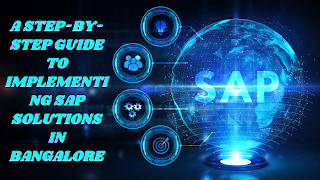A Step-by-Step Guide to Implementing SAP Solutions in Bangalore
Introduction:
Implementing SAP solutions can be a complex process, but with proper planning and execution, you can successfully implement SAP in Bangalore. In this blog post, we will provide you with a step-by-step guide to help you through the implementation process.
Step 1: Define Your Objectives
Clearly outline the goals and objectives of implementing SAP solutions in your organization. Identify the specific business processes and areas that you want to improve or optimize using SAP. This will provide a clear direction for your implementation project.
Step 2: Assemble a Project Team
Form a dedicated project team comprising key stakeholders from different departments. Include representatives from IT, finance, operations, HR, and other relevant areas. This team will be responsible for driving the implementation process and ensuring smooth collaboration between different departments.
Step 3: Conduct a Feasibility Study
Evaluate the feasibility of implementing SAP solutions based on your organization's size, budget, resources, and requirements. Determine if SAP is the right fit for your business needs and if the benefits outweigh the costs. This will help you make an informed decision before proceeding further.
Step 4: Choose the Right SAP Solution
Based on your requirements, select the appropriate SAP solution. SAP offers various modules and products tailored for different business functions such as SAP ERP, SAP CRM, SAP SCM, SAP HCM, etc. Consult with SAP experts or consider hiring a consultant to assist in making the right choice.
Step 5: Develop an Implementation Plan
Create a detailed implementation plan that outlines the timeline, milestones, and tasks involved in the implementation process. Define the roles and responsibilities of team members and allocate resources accordingly. This plan will serve as a roadmap for the entire implementation project.
Step 6: Configure and Customize SAP
Once you have the implementation plan in place, start configuring and customizing SAP to meet your organization's specific requirements. This may involve mapping your existing business processes to SAP's functionalities, defining master data, and setting up system parameters.
Step 7: Data Migration
Migrate your existing data to the SAP system.Develop a data migration strategy and execute it systematically to minimize disruptions during the transition.
Step 8: Training and Change Management
Provide comprehensive training to your employees on how to use the new SAP system. Create training materials, conduct workshops, and organize hands-on sessions to familiarize your staff with the SAP functionalities. Additionally, implement change management strategies to ensure a smooth transition and gain user acceptance.
Step 9: System Testing and User Acceptance
Thoroughly test the SAP system to identify and rectify any bugs or issues. Conduct integration testing, performance testing, and user acceptance testing to ensure that the system functions as expected. Address any feedback or concerns raised by end-users during this stage.
Step 10: Go-Live and Post-Implementation Support
After successful testing and user acceptance, it's time to go-live with the SAP system. Execute the planned cutover activities, migrate the remaining data, and transition to the new system. Provide post-implementation support to address any immediate issues and ensure a smooth transition to regular operations.
Conclusion:
Implementing SAP solutions in Bangalore requires careful planning, coordination, and execution. By following this step-by-step guide, you can streamline the implementation process and maximize the benefits of SAP for your organization. Remember to involve key stakeholders, allocate resources effectively, and provide proper training and support to ensure a successful implementation.




Comments
Post a Comment